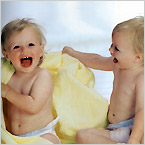Toddlers see the big picture rather than details

Washington, Oct 18 : Young toddlers are more likely to focus on the whole object than on details when learning language, says a new study.
The study conducted at the Purdue University found that when children were taught about an object’s part their main focus remained confined to the object as a whole.
In order to stop the bias, the researchers said that the parents should emphasise more on the part of the object they want to explain because the child’s focus might just be on the object as a whole.
"This new research shows that as young toddlers learn language, they are more likely to focus on objects rather than parts," George Hollich, director of Purdue's Infant Language Lab, assistant professor of psychological sciences said.
"Because of this bias, children automatically assume you are talking about an object. So, when labelling more than just an object, adults need to do something special such as pointing at the part while saying its word or explaining what the item does,” he said.
Supporting the study with the help of an example, like--when introducing a young toddler to a dog, the child automatically thinks of the object as a dog --the researchers said that if adults wanted to talk about the dog's tail or its bark, then they need to be more explicit when communicating with the child.
In the study, 48 children between 12 to 19-months participated. The reason for choosing this particular age group was that children’s vocabularies were in the beginning stages of development.
During the study, the young toddlers were introduced to familiar objects, such as a cup with a lid and a shoe with laces, and two made up objects that were wood cutouts and could be separated. One part of these wood cutouts was designed to be more attractive to a child.
With the part’s visual appeal, Hollich found the children paid more attention to the entire object than to the part.
"We expected that because infants are so taken by the part's salience, specifically bright colours and geometric patterns, they would fail to learn the name for a whole object and instead associate the name with the perceptually interesting and separate part," Hollich said.
"But we found the opposite. This reinforces that children, even as young as 12 months old, make assumptions about what words might mean. And like all assumptions, sometimes they can be wrong. There is a lot going on when infants and young children learn language," he said.
"In addition to parents emphasizing an object, its parts and its function when talking to children, parents also should reduce background noises and look at children as they speak to them,” he added.
The study will be published in the journal Developmental Psychology. (ANI)